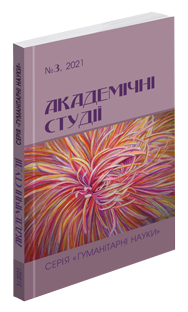Abstract
The proposed scientific research is devoted to the interpretation of the “overall size” parameter in the definitions of zoonymic lexis, selected from three authoritative lexicographic sources of Modern English. It was found that presenting the spatial characteristics of the objects of the material world at the linguistic level, parametric adjectives are characterized, on the one hand, by the simplicity of interpretation and determination of their meaning as empirical adjectives, which reflect the features of objects that are perceived perceptually. It makes their semantics relatively transparent and stable. On the other hand, the lack of clear fixed limits of their use, clearly defined standards of comparative constructions allows for their further semantic development and deviation in the interpretation of the dimensional characteristics of objects. Therefore, the identification of the peculiarities of the use of parametric adjectives and lexical constructions that denote the overall size of real-world reference objects is an urgent problem both from the point of view of the theoretical and from the point of view of the practical aspects of the lexicographic representation of lexemes-zoonyms in different types of linguistic dictionaries. In particular, it is indicated that zoonym definitions introduce information about the overall size of the animal at the beginning of the dictionary definition. In this case, the adjectives “large” and “small” have the highest frequency rates, indicating the general impression of the animal. The use of comparative constructions is also observed, in which we receive an indication of a similar animal, which simplifies the identification of the referent by the reader, or additionally introduces data on the size ratio. In a large number of zoonym definitions, the parameter “overall size” is omitted. However, these are mainly well-known representatives of the fauna world, which are usually not difficult to recognize by humans. The article discusses the issues of the parametric norm, standard, as well as the grading of adjectives. In general, it was determined that the proposed methods of lexicographic description of zoonymic vocabulary require improvement and a unified approach, since the authors of dictionaries often do not follow the principles of adequacy and sufficiency, which leads to difficulties in interpreting the information presented in a dictionary entry.
References
Жуйкова М. В., Йодловская А. И. К проблеме построения словарных толкований конкретной именной лексики (флора и фауна). Вопросы лексикографии, 2021. № 19. C. 52–74. DOI: 10.17223/22274200/19/3.
Collins COBUILT English Dictionary for Advanced Learners. 3d edition. India : Thomson Press, 2001. 1824 p.
Hornby A. S. The Oxford Advanced Learner’s Dictionary of Current English. V. 1, 2. М. : Рус. Яз., 1982.
The Longman Dictionary of Contemporary English. New edition. P. Cm. Pearson Education, 2005. 1950 р.
Wassenburg S. I., Koning de B. B., Bos L. T., Van der Schoot M. Size does matter: Implied object size is mentally simulated during language comprehension. Discourse processes. 54 (7), 2016. Pages: 493–503.
Zhiguo Xie. Where is the Standard? An Analysis of Size Adjectives as Degree Modifiers at the Semantic Pragmatic Interface. Language and Linguistics, 2014. Volume: 15. Issue: 4. Pages: 513–538.

